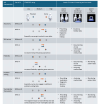AI Interventions to Alleviate Healthcare Shortages and Enhance Work Conditions in Critical Care: Qualitative Analysis
- PMID: 39805110
- PMCID: PMC11773285
- DOI: 10.2196/50852
AI Interventions to Alleviate Healthcare Shortages and Enhance Work Conditions in Critical Care: Qualitative Analysis
Abstract
Background: The escalating global scarcity of skilled health care professionals is a critical concern, further exacerbated by rising stress levels and clinician burnout rates. Artificial intelligence (AI) has surfaced as a potential resource to alleviate these challenges. Nevertheless, it is not taken for granted that AI will inevitably augment human performance, as ill-designed systems may inadvertently impose new burdens on health care workers, and implementation may be challenging. An in-depth understanding of how AI can effectively enhance rather than impair work conditions is therefore needed.
Objective: This research investigates the efficacy of AI in alleviating stress and enriching work conditions, using intensive care units (ICUs) as a case study. Through a sociotechnical system lens, we delineate how AI systems, tasks, and responsibilities of ICU nurses and physicians can be co-designed to foster motivating, resilient, and health-promoting work.
Methods: We use the sociotechnical system framework COMPASS (Complementary Analysis of Sociotechnical Systems) to assess 5 job characteristics: autonomy, skill diversity, flexibility, problem-solving opportunities, and task variety. The qualitative analysis is underpinned by extensive workplace observation in 6 ICUs (approximately 559 nurses and physicians), structured interviews with work unit leaders (n=12), and a comparative analysis of data science experts' and clinicians' evaluation of the optimal levels of human-AI teaming.
Results: The results indicate that AI holds the potential to positively impact work conditions for ICU nurses and physicians in four key areas. First, autonomy is vital for stress reduction, motivation, and performance improvement. AI systems that ensure transparency, predictability, and human control can reinforce or amplify autonomy. Second, AI can encourage skill diversity and competence development, thus empowering clinicians to broaden their skills, increase the polyvalence of tasks across professional boundaries, and improve interprofessional cooperation. However, careful consideration is required to avoid the deskilling of experienced professionals. Third, AI automation can expand flexibility by relieving clinicians from administrative duties, thereby concentrating their efforts on patient care. Remote monitoring and improved scheduling can help integrate work with other life domains. Fourth, while AI may reduce problem-solving opportunities in certain areas, it can open new pathways, particularly for nurses. Finally, task identity and variety are essential job characteristics for intrinsic motivation and worker engagement but could be compromised depending on how AI tools are designed and implemented.
Conclusions: This study demonstrates AI's capacity to mitigate stress and improve work conditions for ICU nurses and physicians, thereby contributing to resolving health care staffing shortages. AI solutions that are thoughtfully designed in line with the principles for good work design can enhance intrinsic motivation, learning, and worker well-being, thus providing strategic value for hospital management, policy makers, and health care professionals alike.
Keywords: AI; ICU; artificial intelligence; autonomy; burden; burnout; competence; employee; flexible; future of work; health care professional; health care professionals; hospital; intensive care; job; new work; occupational health; overburdened; satisfaction; sociotechnical; sociotechnical system; stress; stress mitigation; task; work; work design; worker; workplace.
©Nadine Bienefeld, Emanuela Keller, Gudela Grote. Originally published in the Journal of Medical Internet Research (https://www.jmir.org), 13.01.2025.
Conflict of interest statement
Conflicts of Interest: None declared.
Figures



Similar articles
-
Improvements in Patient Monitoring in the Intensive Care Unit: Survey Study.J Med Internet Res. 2020 Jun 19;22(6):e19091. doi: 10.2196/19091. J Med Internet Res. 2020. PMID: 32459655 Free PMC article.
-
The effectiveness of mindfulness based programs in reducing stress experienced by nurses in adult hospital settings: a systematic review of quantitative evidence protocol.JBI Database System Rev Implement Rep. 2015 Oct;13(10):21-9. doi: 10.11124/jbisrir-2015-2380. JBI Database System Rev Implement Rep. 2015. PMID: 26571279
-
Integrating Nurse Preferences Into AI-Based Scheduling Systems: Qualitative Study.JMIR Form Res. 2025 Jun 4;9:e67747. doi: 10.2196/67747. JMIR Form Res. 2025. PMID: 40466089 Free PMC article.
-
Causes and solutions to workplace psychological ill-health for nurses, midwives and paramedics: the Care Under Pressure 2 realist review.Health Soc Care Deliv Res. 2024 Apr;12(9):1-171. doi: 10.3310/TWDU4109. Health Soc Care Deliv Res. 2024. PMID: 38662367 Review.
-
Healthcare stakeholders' perceptions and experiences of factors affecting the implementation of critical care telemedicine (CCT): qualitative evidence synthesis.Cochrane Database Syst Rev. 2021 Feb 18;2(2):CD012876. doi: 10.1002/14651858.CD012876.pub2. Cochrane Database Syst Rev. 2021. PMID: 33599282 Free PMC article.
Cited by
-
Confirmatory factor analyses of the Mandarin Chinese version of the perceived stressors in intensive care units among healthcare professionals.Front Public Health. 2025 Mar 3;13:1434440. doi: 10.3389/fpubh.2025.1434440. eCollection 2025. Front Public Health. 2025. PMID: 40098796 Free PMC article.
-
Can artificial intelligence revolutionize healthcare in the Global South? A scoping review of opportunities and challenges.Digit Health. 2025 Jun 30;11:20552076251348024. doi: 10.1177/20552076251348024. eCollection 2025 Jan-Dec. Digit Health. 2025. PMID: 40605996 Free PMC article. Review.
References
-
- Sousa A, Scheffler RM, Nyoni J, Boerma T. A comprehensive health labour market framework for universal health coverage. Bull World Health Organ. 2013;91(11):892–894. doi: 10.2471/BLT.13.118927. https://europepmc.org/abstract/MED/24347720 BLT.13.118927 - DOI - PMC - PubMed
-
- WHO guideline on self-care interventions for health and well-being, 2022 revision. World Health Organization; 2022. [2023-07-06]. https://clacaidigital.info/handle/123456789/1654 . - PubMed
-
- Boniol M, Kunjumen T, Nair TS, Siyam A, Campbell J, Diallo K. The global health workforce stock and distribution in 2020 and 2030: a threat to equity and 'universal' health coverage? BMJ Global Health. 2022;7(6)::e009316. doi: 10.1136/bmjgh-2022-009316. https://gh.bmj.com/lookup/pmidlookup?view=long&pmid=35760437 bmjgh-2022-009316 - DOI - PMC - PubMed
-
- Zhang X, Lin D, Pforsich H, Lin VW. Physician workforce in the United States of America: forecasting nationwide shortages. Hum Resour Health. 2020;18(1):8. doi: 10.1186/s12960-020-0448-3. https://human-resources-health.biomedcentral.com/articles/10.1186/s12960... 10.1186/s12960-020-0448-3 - DOI - DOI - PMC - PubMed
MeSH terms
LinkOut - more resources
Full Text Sources
Medical

